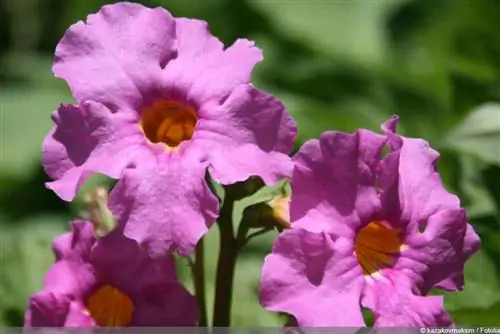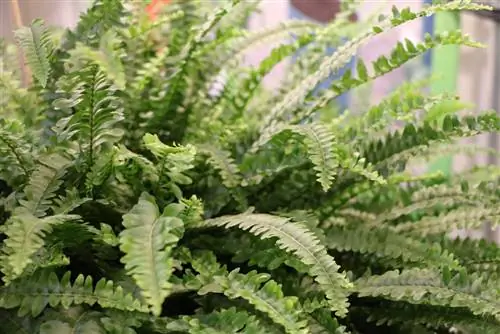- Author admin [email protected].
- Public 2023-12-17 03:39.
- Last modified 2025-01-24 12:45.
Tree ferns are a relic from prehistoric times: huge forests dominated the face of the earth at the time of the dinosaurs. Today the exotic-looking giants are still native to tropical and subtropical regions. They are also often cultivated as ornamental plants, but require frost-free overwintering. Only a few species can tolerate short-term light frost. However, overwintering outdoors is not recommended.
Tree ferns are not hardy
The tropical and subtropical regions of the world, especially the rainforests, are the natural home of tree ferns. The approximately 620 different species of the genus Cyathea or cup fern are primarily native to Oceania and Australia as well as Central America. There is no temperate climate here with periods of cold or even frost, which is why most tree ferns are not hardy. As a rule, even temperatures of less than five degrees Celsius are difficult to tolerate.
These species tolerate light frost
Some species come from the temperate rainforest climate of Australia, New Zealand, Malaysia and neighboring regions. These tree ferns tolerate short-term light frosts of up to minus four degrees Celsius, sometimes more. However, this slight cold tolerance does not make them winter-hardy ornamental plants - careful overwintering to protect them from frost is also mandatory for these tree ferns. If possible, cultivate it in a sufficiently large container so that the plant can be put away if necessary - for example if there is a cold spell.
How much frost the individual Cyatheales species can tolerate:
- Cyathea australis (Australian tree fern): frost-resistant down to approx. minus seven degrees Celsius
- Cyathea brownii (Norfolk tree fern): tolerates light frost down to minus four degrees Celsius
- Cyathea cooperi (scale tree fern): tolerates light frost down to minus four degrees Celsius
- Cyathea dealbata (silver tree fern): tolerates light frost down to minus four degrees Celsius
Tip:
In addition to the Cyathea species, the Dicksonia species also belong to the group of tree ferns. Similar rules apply to these regarding cold resistance and wintering. For example, despite its Latin name Dicksonia antarctica, the Tasmanian tree fern is only hardy to around minus ten degrees Celsius for a short time. The same applies to the New Zealand tree fern Dicksonia fibrosa.
Does planting in the garden make sense?
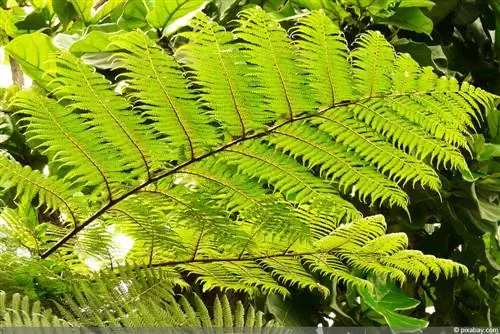
In view of these values, planting in the garden does not seem to make much sense - at least if you are not in a region with mild winters such as the Moselle wine-growing region. Here, the more robust tree ferns can actually be cultivated in the garden all year round, although they often require additional protection. However, if it ever gets really cold, so that the temperatures fall well below zero - and possibly for a long time - planted tree ferns, even if they have been tightly wrapped, can no longer be saved.
Can you overwinter tree ferns outside?
In southern England, where in some regions it is mild all year round due to the Gulf Stream, as well as in Mediterranean countries, stately Cyatheales giants can sometimes be seen in parks and gardens. Some species can grow to be more than ten meters high, but of course do not reach this size in the typical Central European climate with long, often snowy winters. Wherever the climate is suitable, you can leave tree ferns outside. However, you should take appropriate precautions:
- Tie the fronds together or cut back halfway
- Wrap the trunk with thick straw mats
- Cover frond bases with frost protection fleece
- Cover the root area with a thick layer of bark mulch
If the plant is also in a pot, you should place it on an insulating base made of Styrofoam or wood, place it against a warm house wall and also wrap the pot with fleece.
Tip:
Tree ferns tolerate winter sun very poorly, especially since its influence threatens to dry out. Therefore, do not place the plant in direct sun, even if it is warmer there than in partial shade.
Properly care for tree ferns in winter
Overwintering, whether outside or inside, always means stress for exotic plants like the Cyatheales species. You have to protect it against this with good, careful care during the growing season, because a strong, he althy plant survives the rigors of the cold season better. This care plan will help you keep your Cyatheales he althy:
- Partly shaded to shady location, for example under large trees
- Outdoor place sheltered from the wind, preferably near water
- high humidity
- water regularly, wet the trunk and spray the fronds
- nutrient-rich, low-lime and permeable substrate
- fertilize every two weeks between the end of April and the beginning of September
- use liquid fertilizer for this
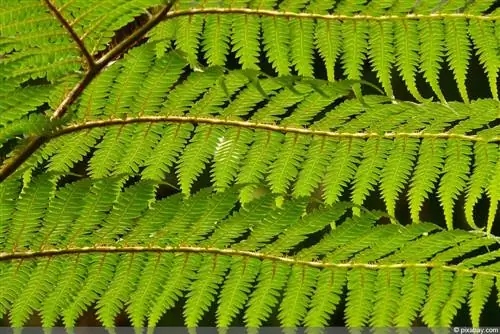
Stop adding fertilizers in September and gradually reduce watering from the same time. But make sure that the plant does not dry out. In winter you need to water less and fertilizing is not necessary in the cold season.
Tip:
In nature, tree ferns grow where it rains a lot and there is constantly high humidity. The water conductivity of these plants is very poor, which is why simply watering the root area is not enough. Instead, the trunk must not dry out and must be moistened regularly.
How to overwinter Cyatheales species in a pot
The best (and safest) way to overwinter tree ferns is in a cold, frost-free room. This applies not only to those grown outside in a pot over the summer months, but also to specimens kept as houseplants. Tree ferns that have wintered warmly suffer from the dry heating air, gradually dry out, become weak and ultimately die. Instead, it's better to put them in a room with
- Temperatures between five and a maximum of ten degrees Celsius
- An unheated winter garden or similar is ideal.
- high humidity
Also, do not place Cyatheales directly next to a window. Sunlight is bad for him, especially in winter, so it can be a little darker instead. However, a completely dark basement is not a good idea either; a good middle ground might be a stairwell that is not too bright or the back area of a winter garden or a garden shed. Water the plant moderately, not forgetting the trunk. Spraying the fronds from time to time is also very good for tree ferns. No further care measures are necessary.
The right time to put away your winter quarters
However, do not evict Cyatheales to winter quarters suddenly and without any warning. Prepare it gradually and the shock to the plant will be less. Start by stopping fertilization and gradually reducing watering amounts. Leave the plant outside for as long as possible, weather permitting. However, by the beginning of October at the latest, it is time to move into winter quarters, because from this point on the nights can start to get very cold.
Preparing for clearing out in spring
Clearing out in the spring should also be done carefully. Start slowly increasing the amount of water around the end of March / beginning of April. However, avoid overwatering, because despite their need for humidity, tree ferns cannot tolerate waterlogging. You can finally fertilize again from the end of April. The plant can go outside as soon as there is no longer any threat of night frost. In most regions, this should be the case from around mid to late May. However, if it is still cold and rainy at this point, you should wait a while before clearing out.
What to do if the fronds become dry and brown?
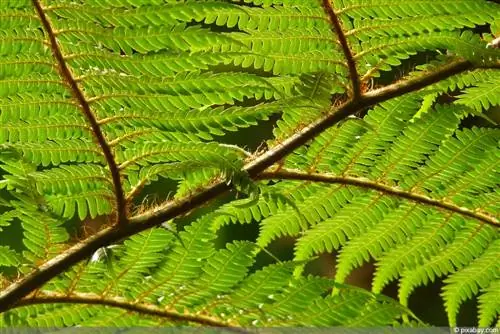
If the fern fronds become dry, tree ferns are probably too dry. Cut off the brown fronds (they no longer turn green) and spray the plant regularly, even in winter. Also avoid heating air and direct sunlight.
Tip:
If you like the look of tree ferns but are looking for a frost-hardy plant, you should look at the hardy palm trees. Hemp palms, for example, can tolerate frost down to minus 25 degrees Celsius and can be easily planted in the garden.


